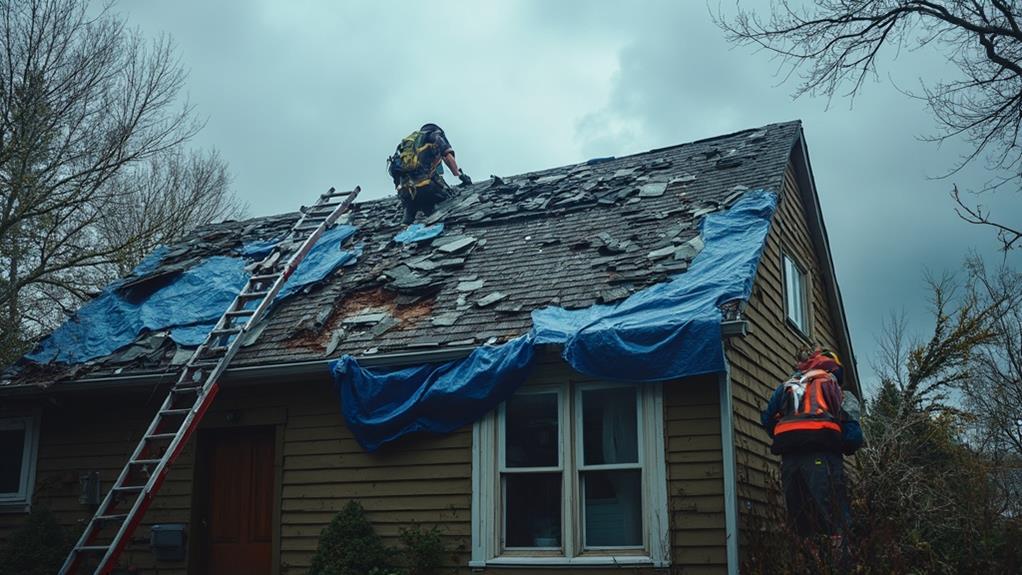After a storm, prioritize safety when assessing roof damage. Use binoculars from the ground to spot issues, and only climb a ladder if it's secure. Document all damage with photos and detailed notes for insurance purposes. Prevent further water intrusion by covering damaged areas with tarps and clearing gutters. Contact your insurance company promptly to initiate a claim. Implement temporary repairs using roofing tar or plywood for larger holes, but avoid walking on wet or damaged sections. Hire a professional roofer for thorough assessment and permanent repairs. Taking swift action can minimize damage and protect your home's integrity. The following steps provide a comprehensive guide for emergency roof repairs.
Assess Damage Safely
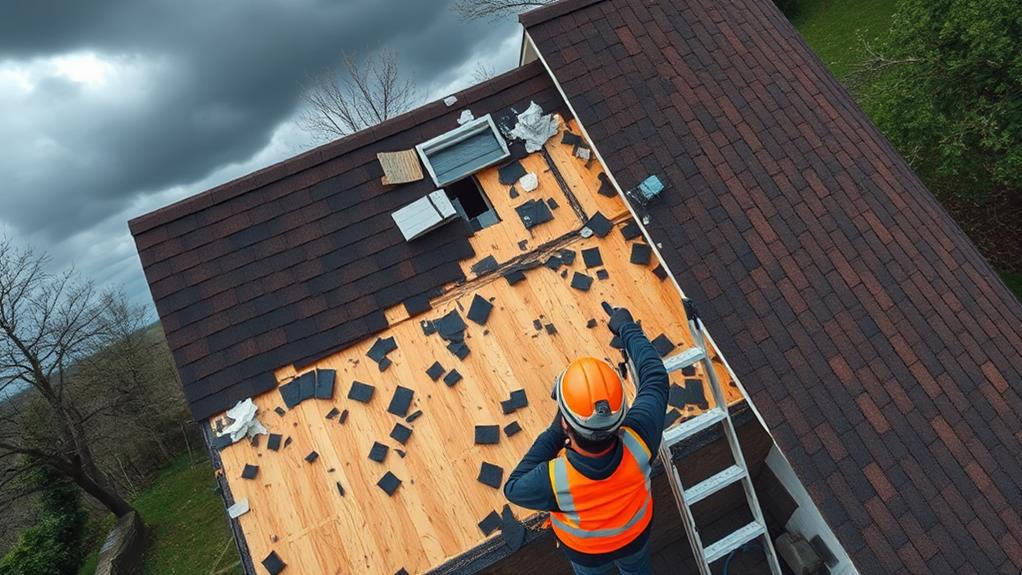
Safety is paramount when assessing roof damage during an emergency. Before attempting any inspection, ensure that the storm has completely passed and it's safe to go outside. Wait for daylight hours to conduct a thorough assessment, as poor visibility can lead to accidents.
Begin by examining your roof from the ground using binoculars. Look for obvious signs of damage such as missing shingles, damaged flashing, or debris on the roof. If you must climb a ladder, ensure it's securely positioned on level ground and have someone hold it steady. Never attempt to walk on a wet or damaged roof.
Inside your home, check for water stains on ceilings and walls, which may indicate roof leaks. Inspect your attic for dampness, mold, or daylight coming through the roof boards. Document all damage with photographs for insurance purposes.
If you suspect structural damage or encounter any hazards, such as downed power lines, immediately contact professionals. Remember, your safety is more important than immediate repairs. Temporary solutions like tarps can be used to prevent further water damage until a qualified roofing contractor can perform a comprehensive inspection and necessary repairs.
Document the Destruction
Thoroughly documenting the destruction caused by a roofing emergency is crucial for insurance claims and repair planning. Begin by taking clear, high-resolution photographs of all damaged areas, both from the ground and, if safe, from a ladder or aerial view. Capture wide-angle shots to show the overall extent of the damage, as well as close-ups of specific problem areas.
Make detailed notes describing the damage, including the size of affected areas, types of materials impacted, and any visible structural issues. Record the date and time of the incident, along with weather conditions during and after the event. If possible, gather any fallen debris or materials for inspection by insurance adjusters or contractors.
Create a comprehensive inventory of damaged personal property inside the home due to roof leaks or collapse. Include descriptions, estimated values, and photos of affected items. Keep all receipts for emergency repairs or temporary solutions implemented to prevent further damage. This documentation will be invaluable when filing insurance claims and obtaining accurate repair estimates from roofing professionals.
Prevent Further Water Intrusion
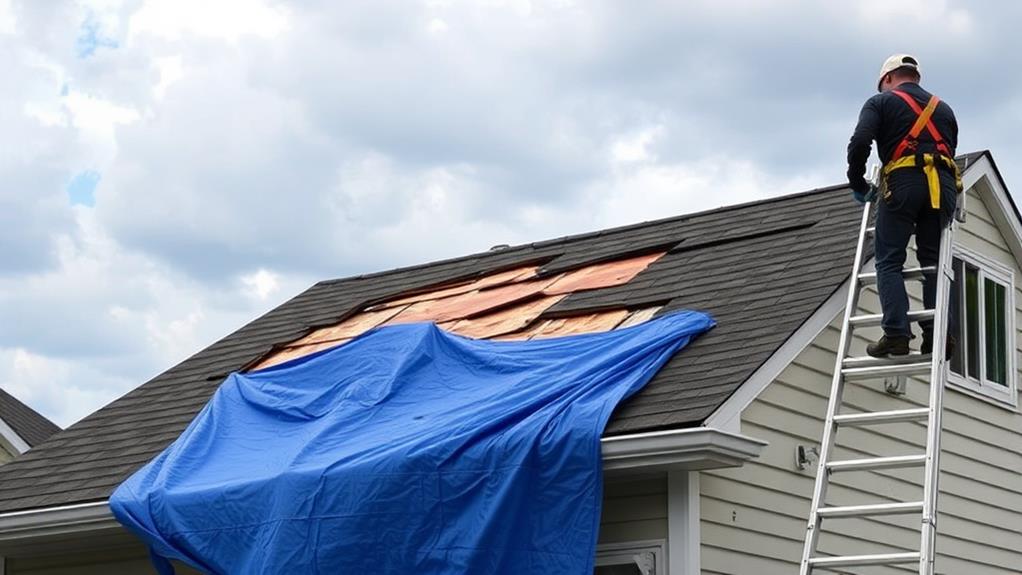
After documenting the damage, the next immediate step is to prevent further water intrusion. This crucial action can mitigate additional harm to your home's interior and structural components.
Begin by identifying all points of water entry, including damaged shingles, exposed underlayment, or compromised flashing.
For temporary protection, use heavy-duty tarps to cover affected areas. Ensure the tarps are large enough to extend beyond the damaged sections, providing adequate overlap. Secure the tarps tightly using sturdy boards and nails, taking care not to create additional holes in undamaged roofing materials. Pay special attention to the edges and corners, as wind can easily lift improperly secured tarps.
If safe to do so, clear debris from gutters and downspouts to facilitate proper water drainage. Inside the home, use buckets to collect water from active leaks and move valuable items away from affected areas.
For extensive damage, consider contacting a professional disaster restoration service to assist with water removal and drying procedures. Remember that these measures are temporary solutions designed to minimize further damage until permanent repairs can be made by a qualified roofing contractor.
Contact Your Insurance Company
Once temporary measures are in place, contacting your insurance company should be your next priority. Promptly notifying your insurer about the roof damage is crucial for initiating the claims process and ensuring timely coverage. Document the damage thoroughly with photographs and detailed notes before any repairs are made, as this evidence will support your claim.
When speaking with your insurance representative, provide a clear account of the incident, including the date and time of the storm. Ask about your policy's specific coverage for roof damage and any deductibles that may apply. Inquire about the next steps in the claims process, such as scheduling an adjuster's visit or obtaining repair estimates.
Request a claim number and keep records of all communications with your insurance company. Be prepared to provide any additional information they may require, such as repair estimates from licensed contractors. If your policy includes provisions for temporary housing due to extensive damage, discuss these options with your insurer. Remember to review your policy carefully and ask questions about any aspects you don't understand to ensure you receive the full benefits you're entitled to under your coverage.
Implement Temporary Repairs
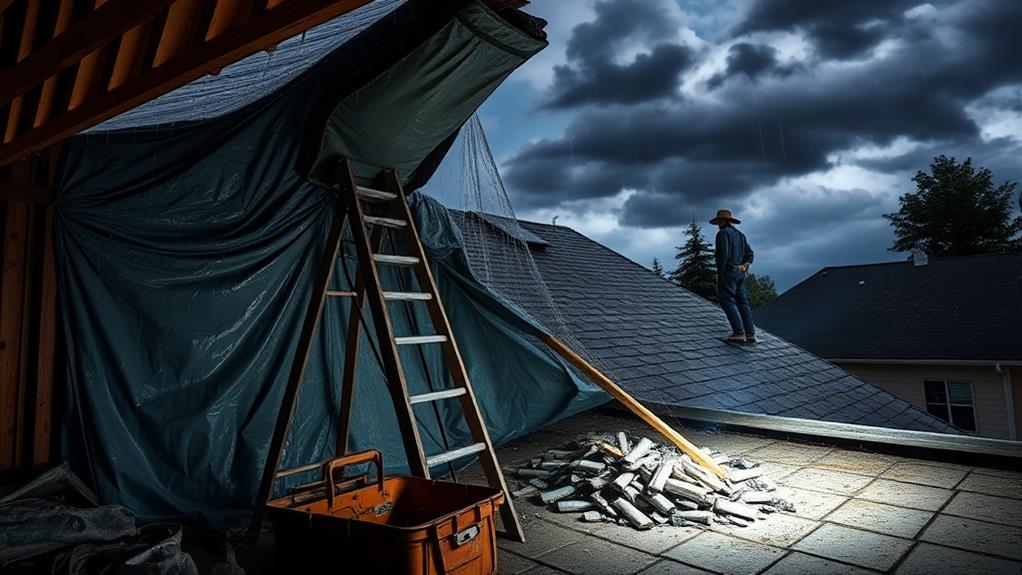
Temporary repairs are essential to prevent further damage to your home while waiting for professional roofers to perform permanent fixes. These measures can help protect your property from water infiltration and structural deterioration. Begin by identifying and addressing the most critical areas of damage, such as holes or torn shingles.
For small holes or cracks, apply roofing tar or cement using a putty knife, then cover with a piece of roofing felt or a patch cut from a spare shingle. Secure larger holes with plywood or plastic sheeting, nailing it in place and covering the edges with roofing tar for a watertight seal.
If shingles are missing, temporarily replace them with spare ones or cover the area with roofing felt.
Ensure proper safety precautions when working on your roof. Use a sturdy ladder, wear non-slip shoes, and avoid walking on wet or damaged areas. If possible, work with a partner for added safety. Remember that these repairs are temporary solutions; professional assessment and permanent repairs should be scheduled as soon as possible to maintain your roof's integrity and protect your home from future weather events.
Hire a Professional Roofer
Securing the services of a qualified professional roofer is crucial for long-term roof repair and maintenance. After implementing temporary measures, it's essential to contact a reputable roofing contractor for a thorough assessment and permanent solution. Look for licensed and insured professionals with extensive experience in storm damage repairs.
When selecting a roofer, request multiple quotes and check references. Avoid contractors who pressure you into immediate decisions or demand large upfront payments. A reliable roofer will provide a detailed written estimate, including materials, labor costs, and project timeline.
During the inspection, the professional will identify hidden damage that may not be visible from the ground. They will assess the structural integrity of the roof, check for water infiltration, and determine if a partial repair or complete roof replacement is necessary.
Hiring a professional ensures proper repairs that comply with local building codes and manufacturer warranties. They have access to high-quality materials and specialized tools, ensuring a durable and weather-resistant repair. Additionally, professional roofers can work with your insurance company to maximize your claim coverage, potentially saving you money on out-of-pocket expenses.
Plan for Long-Term Solutions
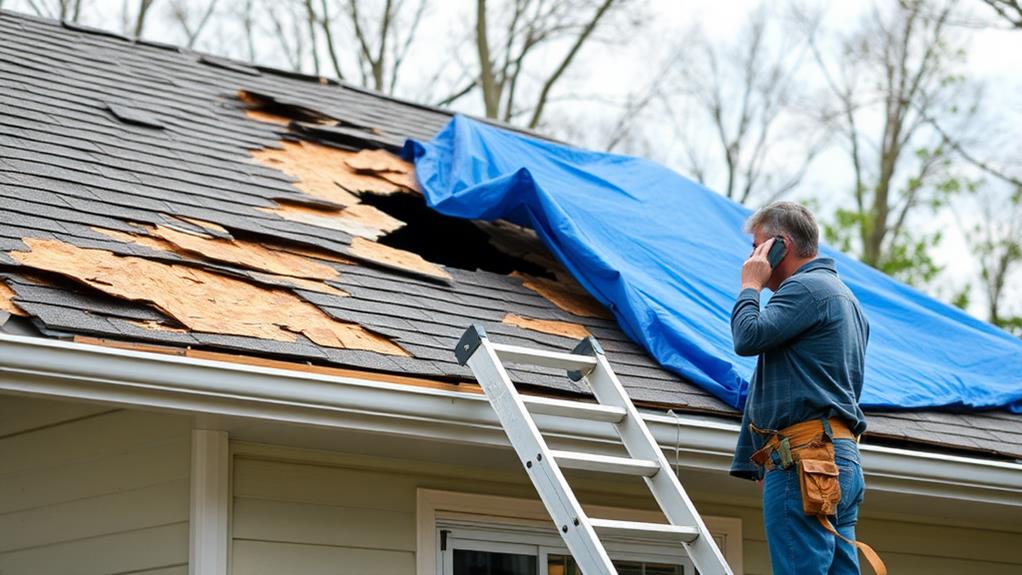
While professional repairs address immediate concerns, planning for long-term solutions is key to maintaining a robust and resilient roof. After emergency repairs, assess the overall condition of your roof to identify potential vulnerabilities. Consider investing in impact-resistant shingles or metal roofing materials that can better withstand future storms. Upgrade your roof's ventilation system to prevent moisture buildup and extend its lifespan.
Implement a regular maintenance schedule, including bi-annual inspections and prompt repairs of minor issues. This proactive approach can prevent small problems from escalating into major emergencies. Additionally, evaluate your roof's age and structural integrity to determine if a full replacement is necessary in the near future.
Consider improving your home's insulation and installing proper drainage systems to minimize the risk of ice dams and water damage. Trim overhanging tree branches to reduce the likelihood of storm-related damage. Finally, review your homeowner's insurance policy to ensure adequate coverage for roof-related incidents. By planning for long-term solutions, you can significantly reduce the risk of future emergencies and protect your home from costly damage.
Frequently Asked Questions
How Long Can I Wait Before Addressing Storm Damage to My Roof?
Addressing storm damage to your roof promptly is crucial. While minor issues may allow a brief delay, significant damage should be addressed immediately. Waiting too long can lead to further deterioration and more extensive, costly repairs.
Can I Claim Roof Repairs on My Taxes?
Generally, roof repairs are not tax-deductible for personal residences. However, if the damage was caused by a federally declared disaster, you may be eligible for a casualty loss deduction. Consult a tax professional for specific guidance.
Will My Homeowner's Insurance Rates Increase After Filing a Storm Damage Claim?
Will your rates increase? It's a valid concern. While filing a storm damage claim doesn't automatically raise premiums, multiple claims or severe damage might impact your rates. Consult your insurance agent for specifics regarding your policy and situation.
Are There Specific Roofing Materials That Better Withstand Severe Weather Conditions?
Several roofing materials offer superior protection against severe weather. Impact-resistant shingles, metal roofing, slate, and clay tiles are known for their durability. Additionally, synthetic materials like rubber or plastic composites can provide excellent resistance to harsh conditions.
How Often Should I Have My Roof Inspected to Prevent Storm-Related Issues?
In a study of 1,000 homes, those with regular roof inspections experienced 60% fewer storm-related issues. Experts recommend annual inspections, with additional checks after severe weather events. This proactive approach helps identify potential weaknesses before they become major problems.
Conclusion
In the aftermath of a storm, swift and decisive action is crucial for emergency roof repairs. By following a systematic approach—from safe assessment to professional intervention—homeowners can mitigate damage and protect their property. As the old adage goes, "A stitch in time saves nine," emphasizing the importance of addressing issues promptly. Proper documentation, temporary fixes, and collaboration with insurance providers pave the way for comprehensive, long-term solutions. Ultimately, a proactive stance safeguards both home and peace of mind.
